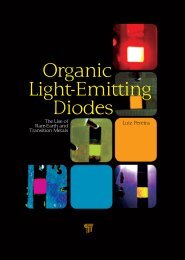Download PDF - Pan Stanford Publishing
Download PDF - Pan Stanford Publishing
Download PDF - Pan Stanford Publishing
Create successful ePaper yourself
Turn your PDF publications into a flip-book with our unique Google optimized e-Paper software.
Introduction to SolarPowerfortheWorld 21<br />
• System price: $5/W<br />
• 4 kW system: $20,000<br />
• Utility “Austin Energy’s” support: $2.5/W = $10,000<br />
• 30% federal tax credit: $3000<br />
• $50 to $60 monthly utility savings<br />
Payback time of 8 years<br />
The US states have the RPS as overall guide for support. It can<br />
be implemented in different ways, as rebate programme of public<br />
utilities or state agencies, or cash incentives. Apart from these<br />
incentives for the up-front cost of a PV system, states may promote<br />
PV as part of the RPS Solar Renewable Energy Certificates (SRECS).<br />
Those certificates are issued like for the FITs per kWh produced<br />
by certified and registered PV systems. They are then sold on a<br />
spot market, auctions, or with long-term contracts. The demand is<br />
determined by the state’s RPS requirements. Moreover, all US states<br />
allow net metering.<br />
The federal investment tax credit ITC can raise tax equity or<br />
cash payment. There is also a “Federal New Market Tax Credit”<br />
for economically depressed regions that allows borrowing at 1%<br />
instead of 7%.<br />
In 2009, California started solar rebate programmes for lowincome<br />
families, the Single Family and the Multi Family Affordable<br />
Solar Homes Programs SASH and MASH.<br />
A big issue in the United States is a choice between the<br />
alternatives “ownership” or “leasing, i.e. Third Party Owned<br />
TPO”. The American people made their choice: between 2010<br />
and 2012 the share of leased PV systems increased from 15%<br />
to 80%. Solar City, the company that was brought successfully to the<br />
stock market in 2012, is one of the largest promoters in the United<br />
States offering lease options. The Property Assessed Clean Energy<br />
(PACE) is similar to solar leasing. It allows homeowners to mortgage<br />
PV and other improvements and pay for the PV benefits only as long<br />
as they own the house. In San Diego, the municipality has set up<br />
FIGTREE for multiple PACE options; it drops the minimum project<br />
size from $50,000 to $5000. Loans are paid with the property taxes<br />
over 20 years.
















